
ChatGPT is all the rage these days and everyone is using it in some way or the other in their lives. Whether it’s for basic questions or high-productivity tasks, ChatGPT is more than capable to help you work better.
This brings up an interesting question:
How can bloggers use ChatGPT to improve their blog and its content?
Well, there are a lot of use cases of ChatGPT for blogging that can help you not only save time but also work in a much better way.
In this article, I’ll be sharing some of the best prompts and use cases of ChatGPT for blogging. I
I’ll be covering some general use cases that you can use ChatGPT for in your blogging work along with some prompt examples for each use case.
That being said, let’s get started.
ChatGPT Use Cases & Prompts For Bloggers
Here are some of the most useful ChatGPT use cases and prompts for bloggers:
Generate Blog Post Ideas
One of the best uses of ChatGPT is to generate blog post ideas and keywords you can target on your blog.
This is one of my favorite use cases of ChatGPT as oftentimes, we face a creative block and have difficulties coming up with new post ideas.
With ChatGPT, you can solve this problem using a prompt as shown below:

This simple prompt can yield so many great blog post ideas.
But that’s not it.
You can go a bit further and give even more detailed or specific prompts to ChatGPT and it’ll spit out great blog post ideas for you like this one:

The best part about ChatGPT is you can tell exactly what kind of output you want. As you can see in the example above, I mentioned not to come up with any review article and it did exactly that.
The result?
Some very interesting blog post ideas that you’d have difficulty coming up with by yourself.
One misconception that a lot of people have about ChatGPT and the use case of generating blog post ideas is that it comes up with ideas that you could find using SEO tools.
So, a lot of people believe that ChatGPT cannot go further than the typical blog post ideas of product reviews and such.
But that’s not true.
If you’re truly creative with your prompts, you can generate some pretty amazing blog post ideas.
Here’s another example:

You don’t want the generic product reviews and list post ideas? Well, using this prompt helps you discover ideas worth sharing on social media.
The point here is that when you’re generating blog post ideas using ChatGPT, you don’t have to limit yourself to basic prompts that will give you ideas for ranking on Google.
Before we move on to the next use case, I want to list down some prompts you’ll find useful when generating blog post ideas using ChatGPT.
Prompt Ideas & Examples
- Suggest X articles for a [niche] blog that reviews [topic].
- Suggest X long-tail blog post ideas for a [niche] blog focused on [topic]. Do not come up with review articles.
- Suggest X blog post ideas for a [niche] blog in the [topic] where I could promote products on Amazon.
- Suggest X blog post ideas for a [topic] blog in the [topic]. Blog post ideas should have a shareability factor so that they could go viral on social media.
- Suggest X blog post ideas related to [another blog post topic].
- Suggest X blog post ideas that may be easier to rank for a new [niche] blog.
- Suggest X long-tail keywords for a [niche] blog. Come up with How-To posts.
- Come up with X blog post ideas for a [niche] blog. Ideas should be of articles that are long and detailed guides.
- Suggest X blog post ideas for a [niche] blog. Ideas should of product comparison articles.
- Suggest X blog post ideas for a [niche] blog. Come up with ideas that have a search demand but are not covered by a lot of blogs.
Find Click-Worthy Titles
Let’s say you find it easy to come up with blog post ideas but not with blog post titles. That’s a struggle a lot of bloggers face.
And we all know how important a good blog post title is not only for the user but also for search engines.
Well, you can use ChatGPT for this as well and come up with click-worthy titles that are interesting and irresistible.
Here’s an example:
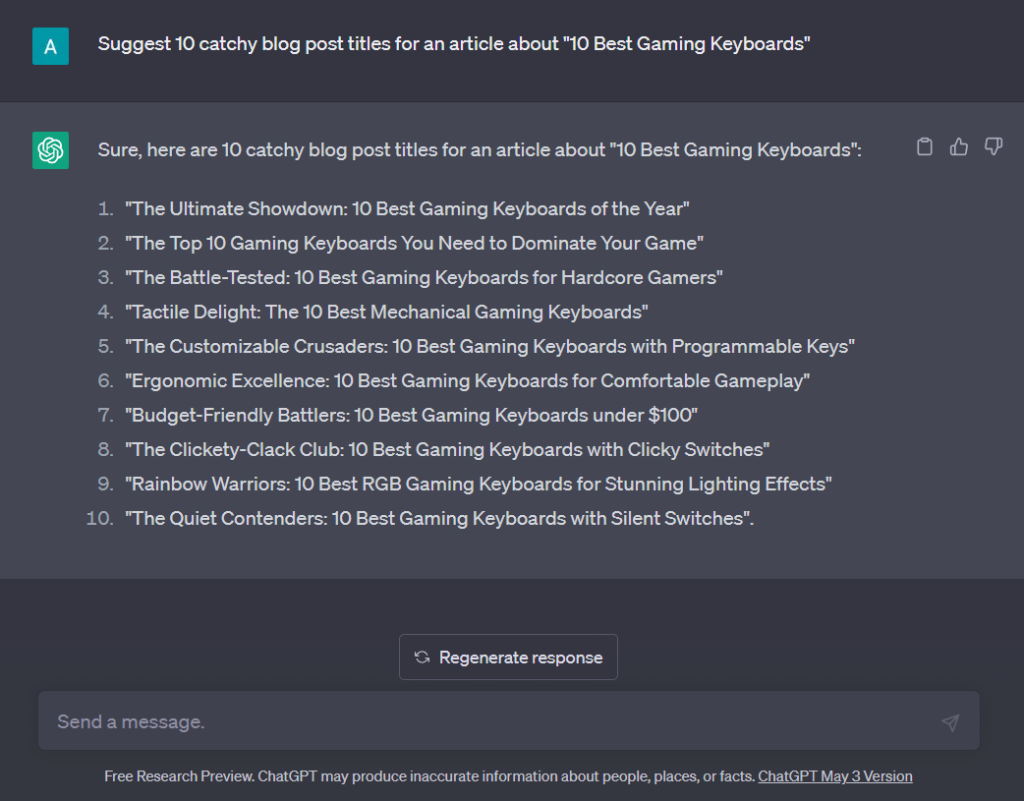
You can go further and tweak your prompts more toward the kind of output you want.
Let’s say you want to find titles that have a good shareability and viral factor. You can use a prompt as shown below and find some really click-worthy titles:

These titles are so good and something that will make you want to click and read the article if you’re on social media.
Similarly, you can also generate blog post titles that are SEO optimized and result in high CTR.
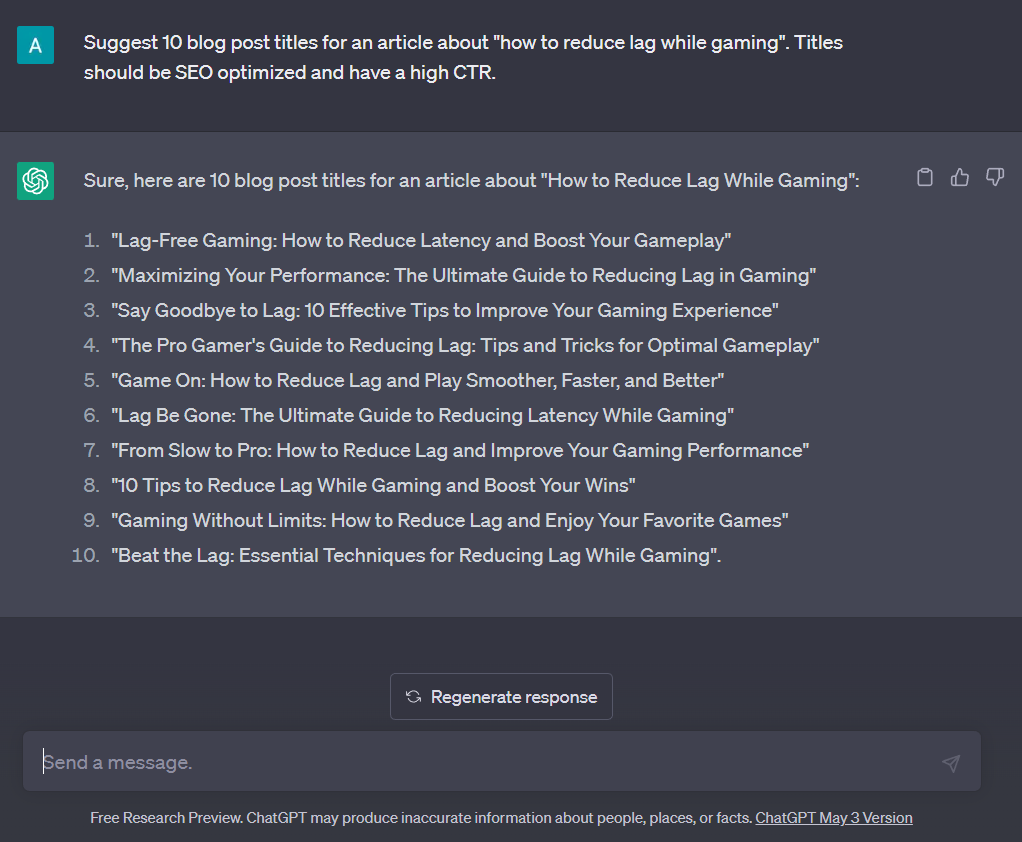
Overall, ChatGPT can be very useful in coming up with blog post titles when you run out of ideas. And even if you don’t struggle with coming up with catchy titles, I’d recommend using ChatGPT to generate titles.
Prompt Ideas & Examples
- Suggest X catchy and SEO-optimized blog post titles for an article about [topic].
- Suggest X catchy blog post titles for an article about [topic].
- Suggest X click-worthy and viral blog post titles for an article about [topic].
- User
- Suggest X blog post titles for an article about [topic]. Titles should be SEO optimized and have a high CTR.
Create Blog Post Outlines
ChatGPT is also useful in generating blog post outlines. While I don’t recommend fully relying on ChatGPT for generating outlines, it’s still useful in getting a general idea of what you can cover in your topic.
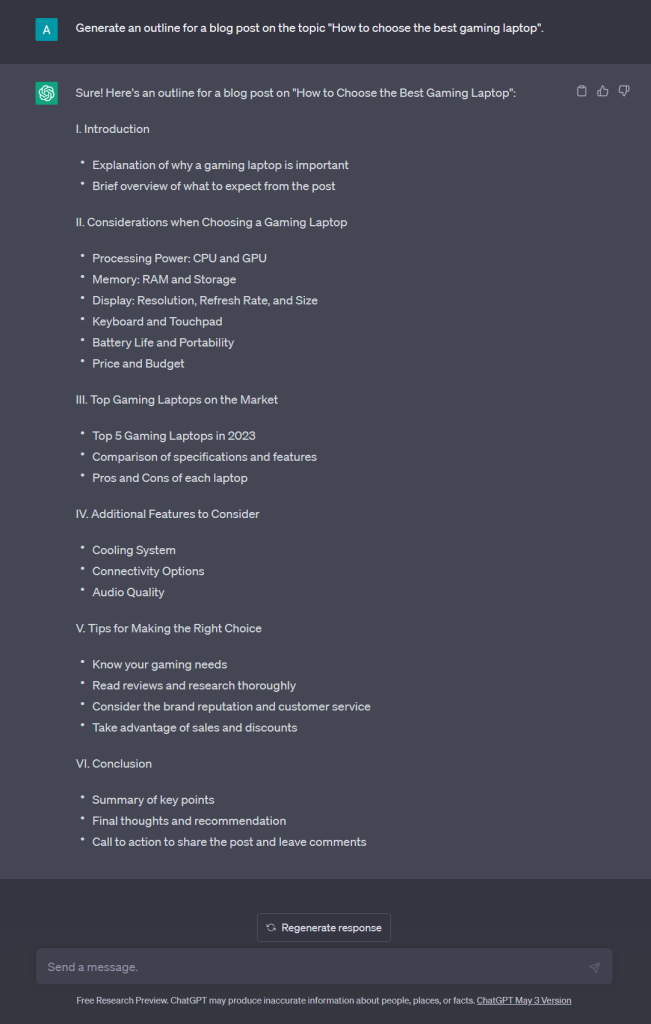
As you can see, the outline generated is quite detailed and covers all aspects of the topic in question.
You can use this generated outline and optimize it further for SEO. Moreover, I’d recommend researching the top-ranking posts to check what they’ve covered in their articles.
The blog post outlines generated using ChatGPT can serve as a very good starting point when you’re working on an article.
You no longer have to sit idle staring at a blank screen wondering where and how to start.
Prompt Ideas & Examples
- Generate an outline for a blog post on the topic [topic name].
- Generate a short outline for a blog post on the topic [topic name].
- Generate an outline for a blog post on the topic [topic name]. The outline should have X headings with X subheadings in each heading.
Generate Full-Form Content
As a blogger, you shouldn’t limit yourself to just generating blog post ideas and outlines using ChatGPT.
If done right, you can also generate full-form content using ChatGPT. Now, there are many questions about whether AI-generated content is good enough for readers and search engines.
And there are arguments that can be made on both sides. What I believe personally is that you can use ChatGPT as an assistant to create better content for your blog.
So, when it comes to generating full-form content, you can use ChatGPT to create content and then optimize it to make it better.
Here’s an example prompt of how you can generate content using ChatGPT for your blog:
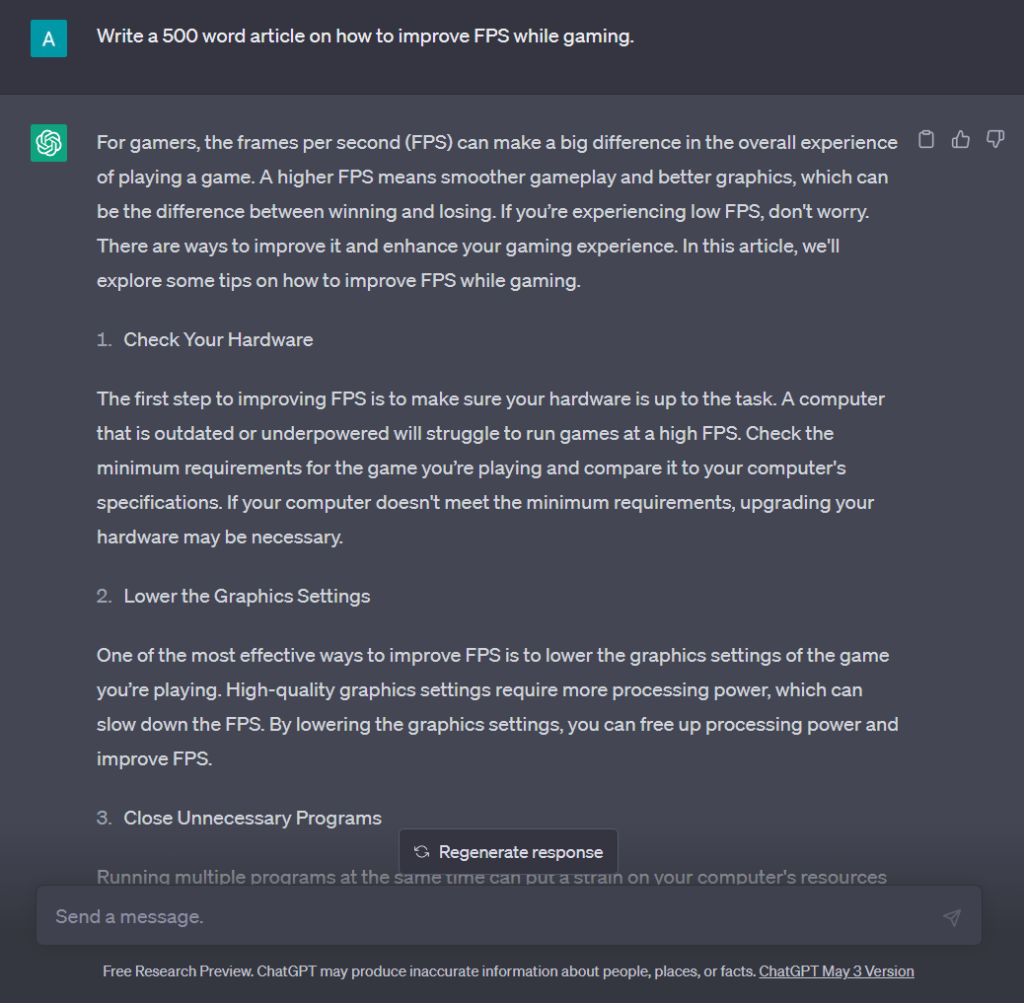
This generated content isn’t good enough to be used on a blog without further optimization and improvement.
But it still gives you a good starting point to write your article. You can take the content generated from the output and improve it further.
Moreover, generating content this way also helps you create better content on topics you might not be fully knowledgeable about.
Besides this, one of the best ways to create content for your blog using ChatGPT isn’t by generating the full content in one go.
A smarter approach to this is by generating sections of your article using ChatGPT as shown in the example below:
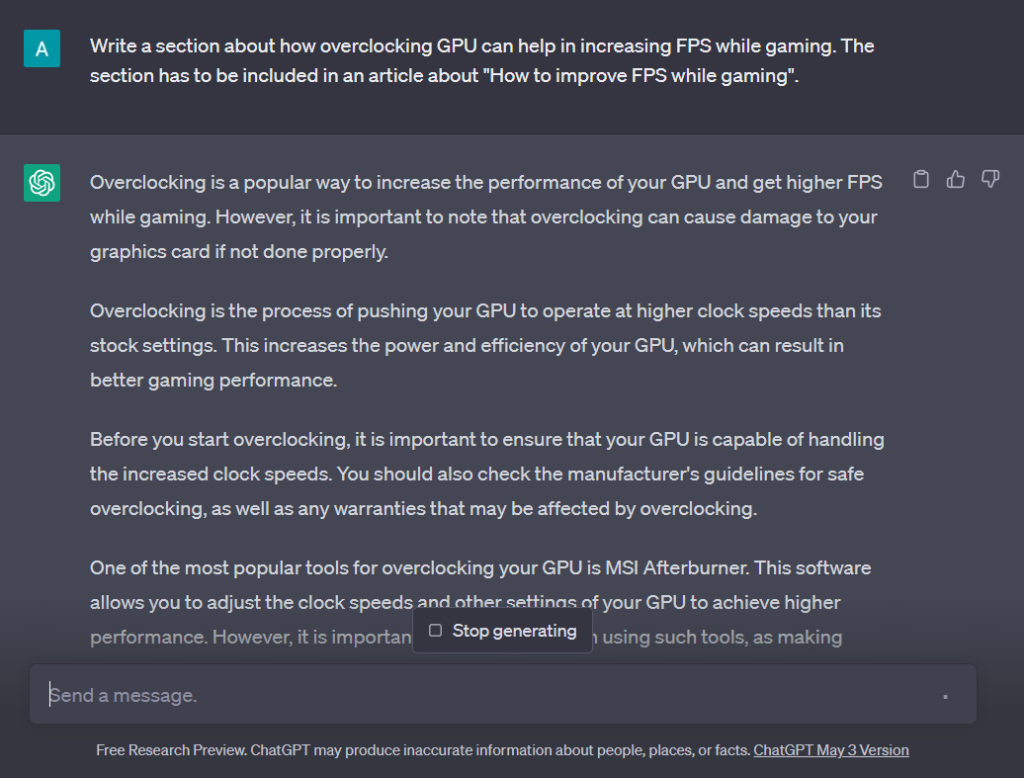
As you can see, this generates a better output for that specific section or subheading of the article.
Now, you can take this output and edit it as you like by removing certain paragraphs and keeping the ones that are more relevant.
Prompt Ideas & Examples
- Write an X-word article on [topic].
- Provide me a list of facts and figures related to [topic] along with links to sources.
- Improve and expand the following copy [paste copy].
- Write a section about [section topic] for an article about [topic]
- Rewrite this copy [paste copy] to be more engaging and simpler to understand.
Write Blog Post Intro & Conclusion
In the previous use case, I mentioned how you can use ChatGPT to generate content for specific sections of your article.
Well, you can do that for the introductions and conclusions of your posts as well.
Since introductions and conclusions are very crucial for any article, it’s important that they’re engaging and grab the attention of the reader instantly.
And you can get some help from ChatGPT in doing so. Here’s an example of writing an introduction for an article using ChatGPT:
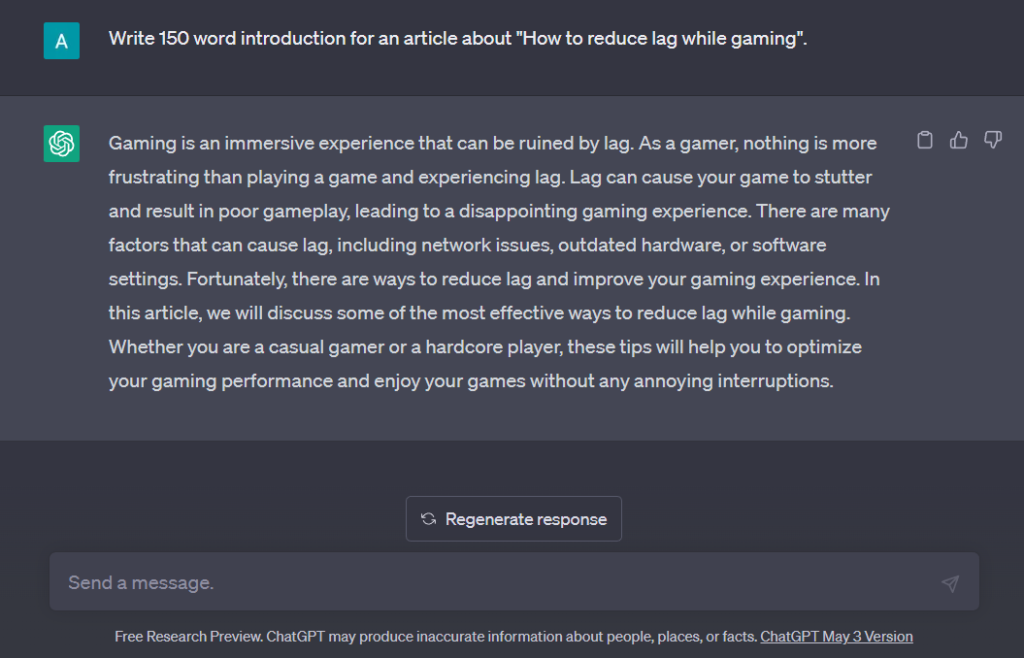
Similarly, you can also generate conclusions for your articles using ChatGPT.
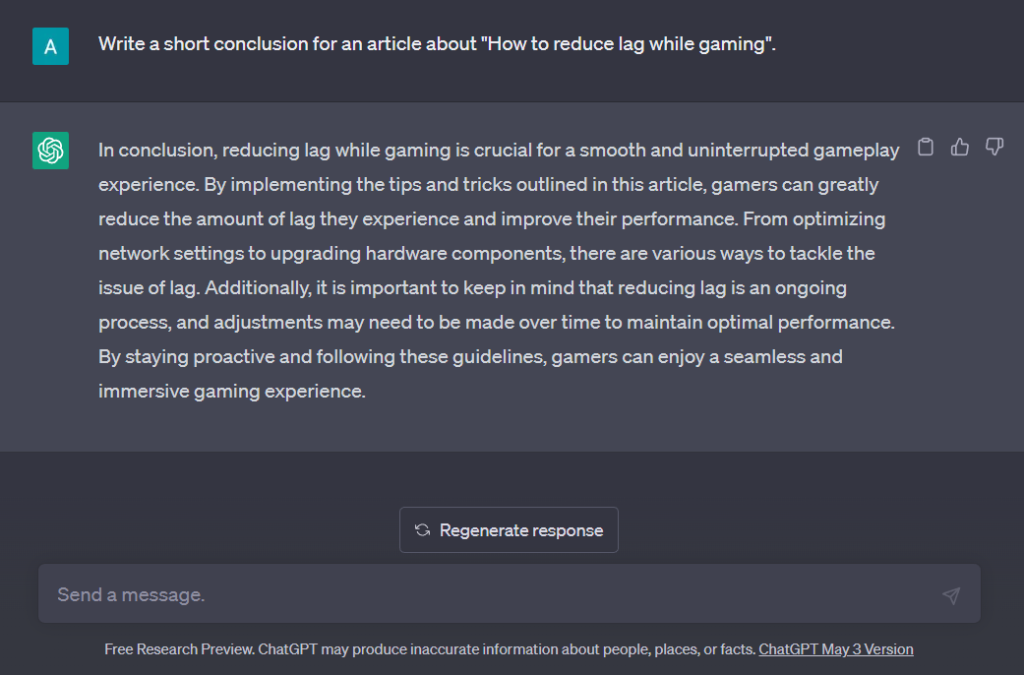
Prompt Ideas & Examples
- Write a short introduction for an article about [topic].
- Write an X-word introduction for an article about [topic].
- Write a short conclusion for an article about [topic].
Generate Meta Descriptions
Let’s face it:
Writing meta descriptions is boring and a tiresome task. We just do it because we want to optimize our content for the search engines.
And this often leads to meta descriptions that aren’t enticing or attention-grabbing.
You can get rid of this problem once and for all by using ChatGPT to generate meta descriptions. Here’s an example prompt to generate meta descriptions for your posts:

You can also customize your prompt to generate an output more suited to your posts or simply make it more engaging.
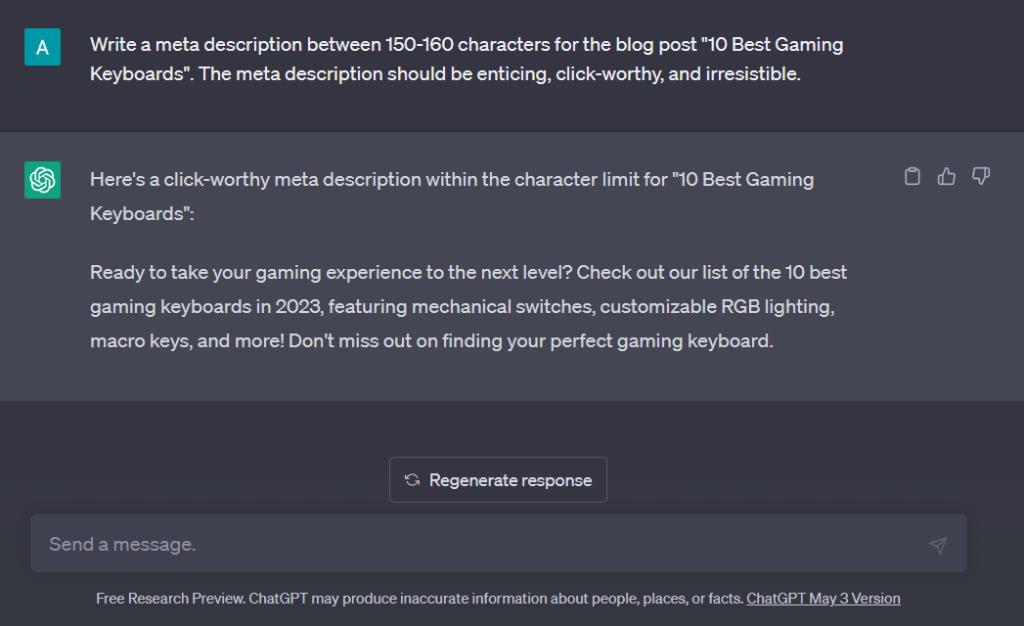
You can also generate separate descriptions for social media as well.
Prompt Ideas & Examples
- Write a meta description between 150-160 characters for the blog post [topic].
- Write a meta description between 150-160 characters for the blog post [topic]. The meta description should be enticing, click-worthy, and irresistible.
- Write a social media meta description for the blog post [topic].
Create FAQs and Answers
FAQs are very useful in many kinds of articles such as product reviews, comparison lists, how-to guides, and tutorials.
Sometimes, you may not know what the frequently asked questions might be for the topic you’re writing.
In cases like these, you can utilize the power of ChatGPT to create FAQs or generate answers for your content.
Here’s an example:
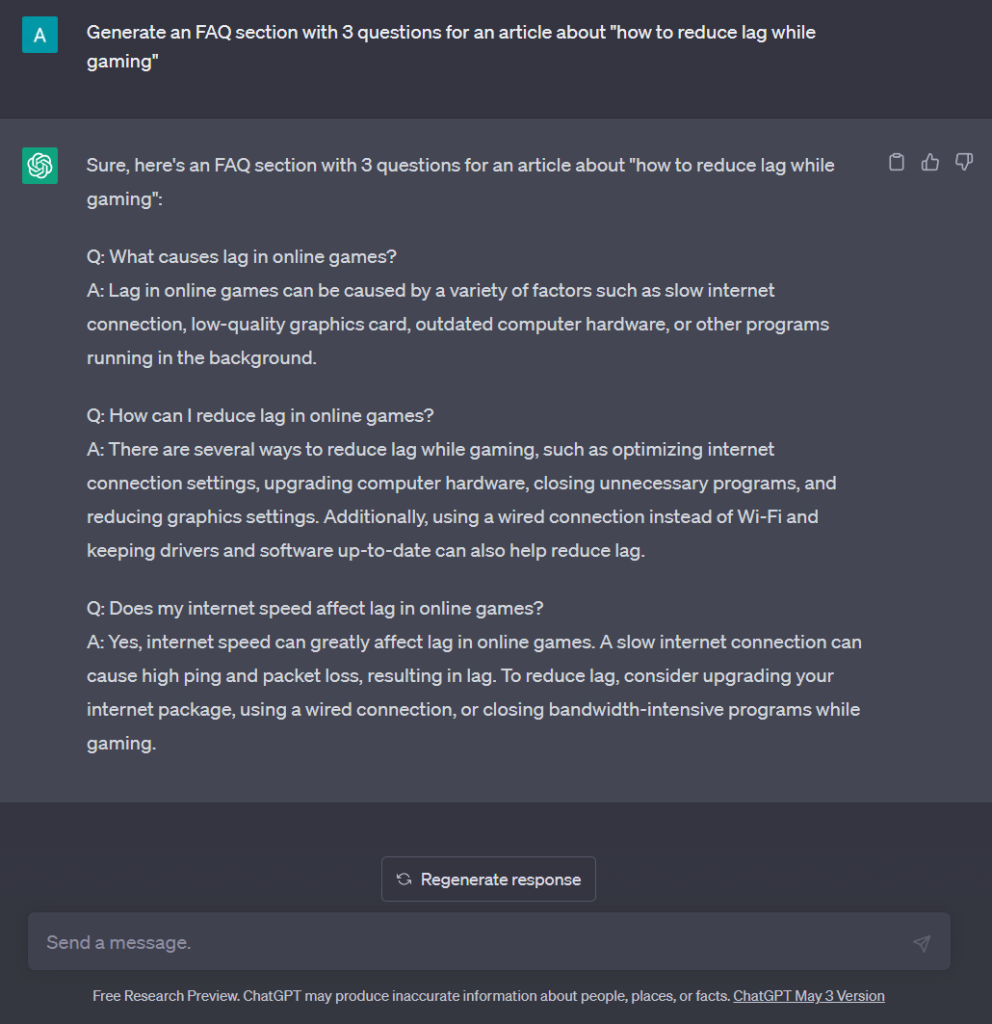
In the example above, I only generated 3 FAQs but you can generate more by either specifying a number. Or you could simply mention nothing and ChatGPT would automatically decide how many FAQs to come up with.
The example above perfectly showcased how ChatGPT can be useful in generating FAQs for a How-To article.
Let’s generate an FAQ for a product comparison guide or list:
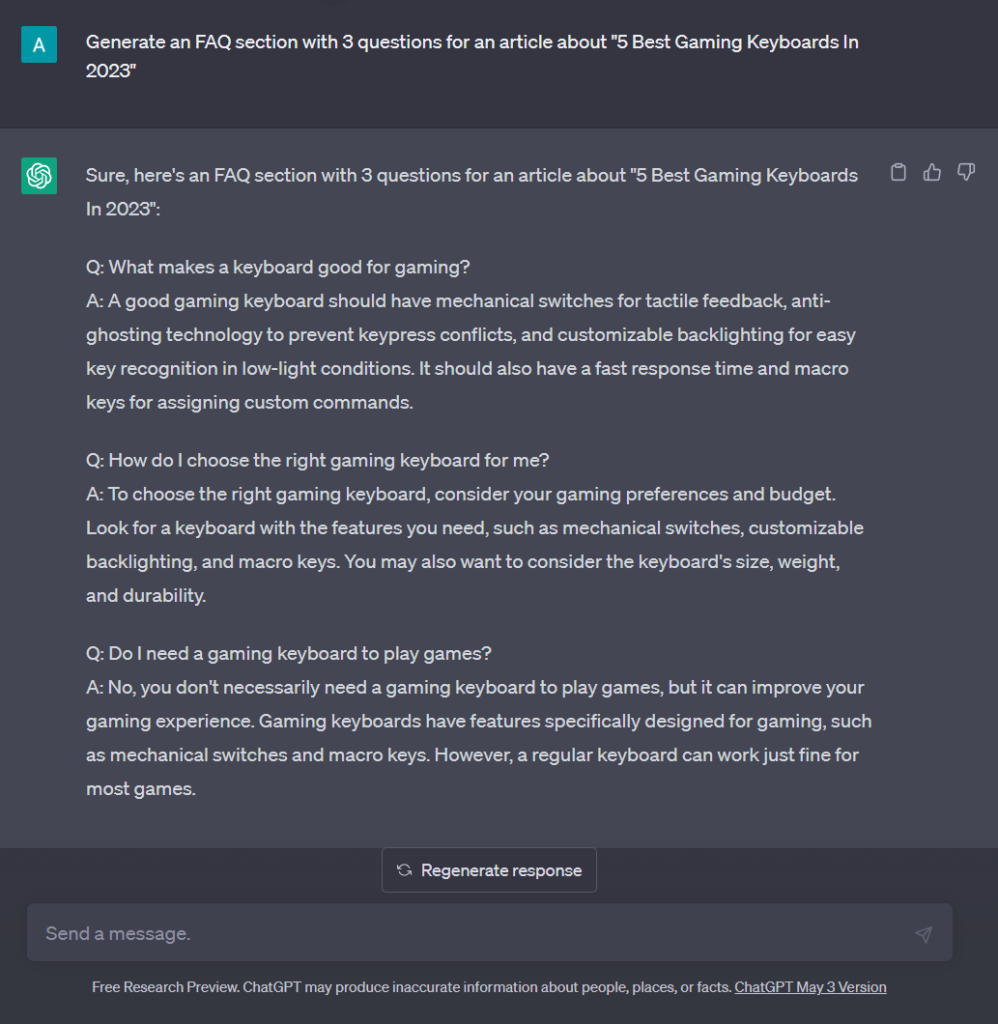
Again, the response by ChatGPT is spot on and can be easily used in product comparison guides or list posts.
You can also word your input differently to generate FAQs in ChatGPT:
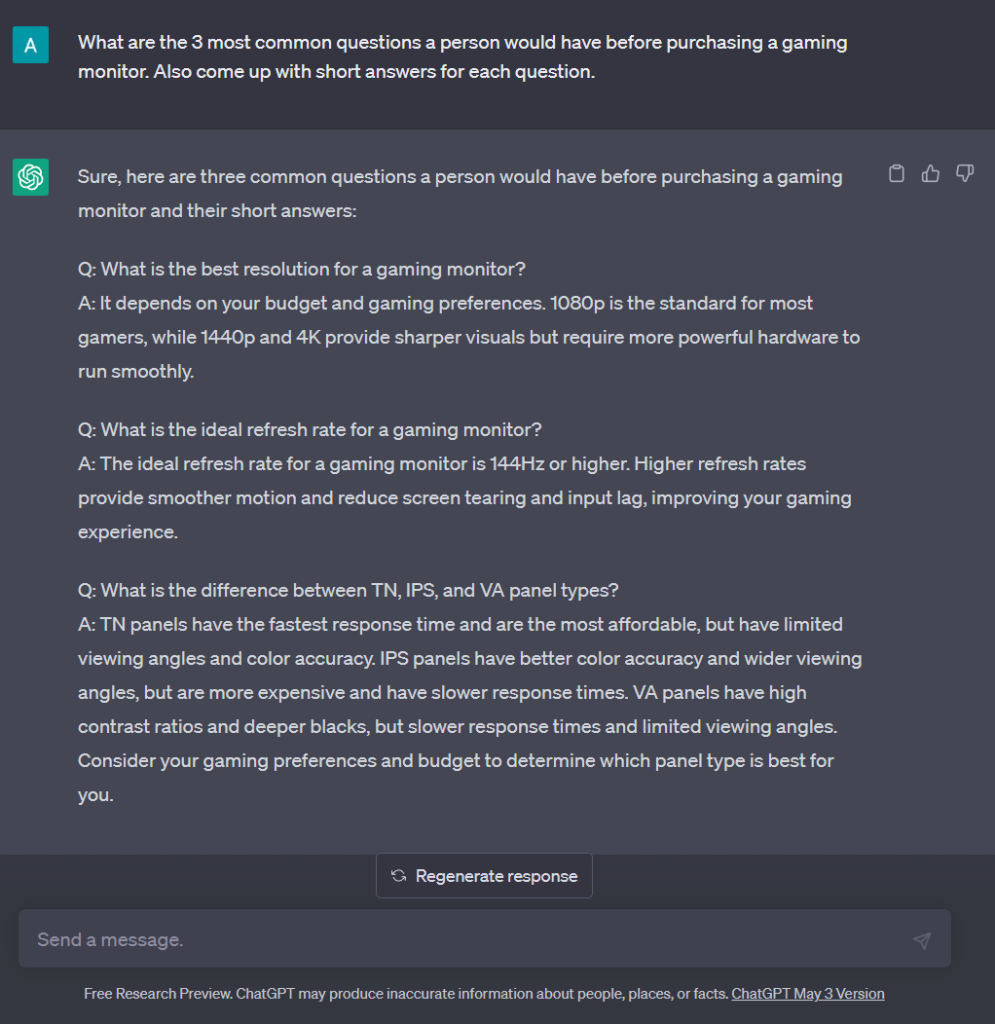
This is another way of creating FAQs or finding answers to questions you want to include in your article.
Prompt Ideas & Examples
- Generate an FAQ section for an article about [topic].
- Generate an FAQ section with X questions for an article about [topic].
- What are the X most common questions a person would have before [topic]? Also come up with short answers for each question.
Write Social Media Posts
Besides creating content for your blog, you can use ChatGPT to improve your social media presence.
You can write social media posts and consistently promote your content across all platforms with the help of ChatGPT.
If you’re someone who struggles to keep up with social media, you can start by finding content ideas for social media.
Here’s an example:
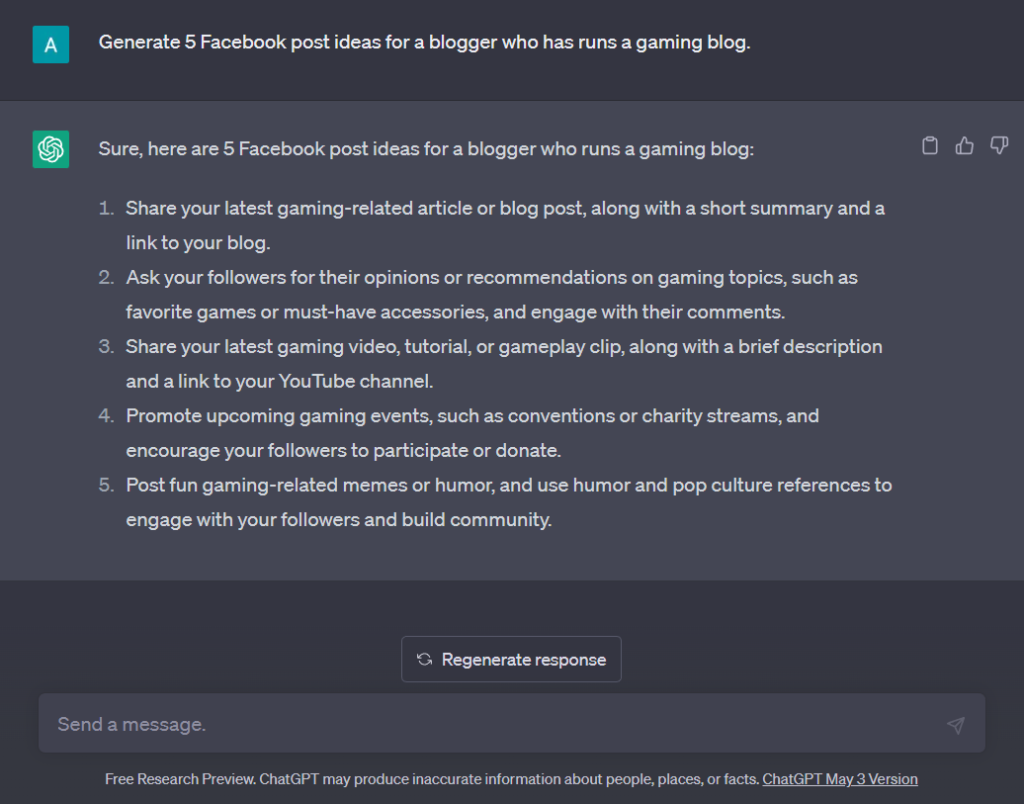
If that’s not enough, you can also generate ideas for reels or shorts to create viral content.

You can also create Twitter threads within seconds using ChatGPT with prompts as shown below:
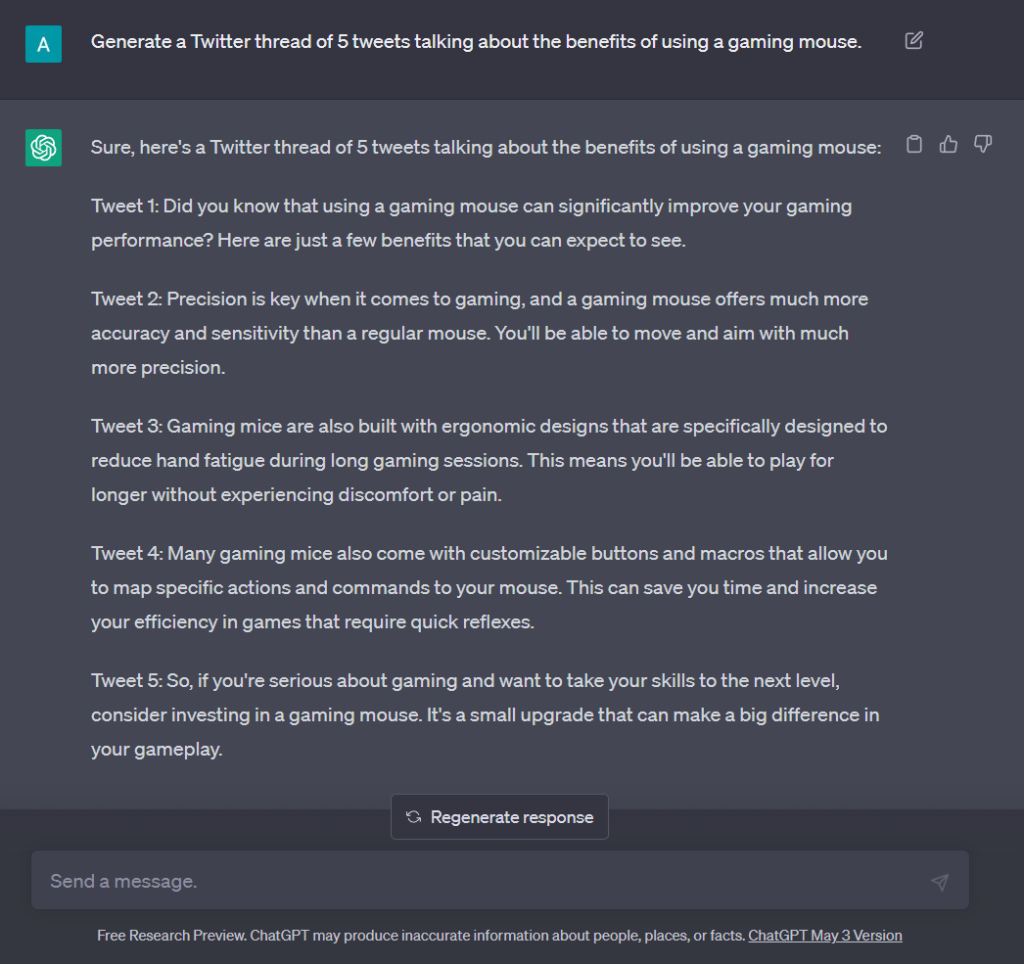
All in all, you can manage your entire social media marketing with the help of ChatGPT. From brainstorming post ideas to generating post copy, you can do it all with the examples shared above.
Prompt Ideas & Examples
- Generate 5 tweet ideas for a blogger who runs a [niche] blog.
- Generate 5 Facebook post ideas for a blogger who runs a [niche] blog.
- Generate an idea for an Instagram reel for someone who runs a [niche] blog. The idea should be creative, unique, and have a virality factor.
- Generate a Twitter thread of 5 tweets talking about the [topic].
- Create a monthly social media calendar for a [niche] blogger who has accounts on Instagram, Twitter, and Facebook. There should be 3 posts a week on all platforms.
Write Newsletters
Finally, the last use case of ChatGPT for blogging is writing newsletters for your email subscribers.
If you have an email list (which you should) but struggle to actively send emails, you can use ChatGPT to come up with newsletter ideas and also write newsletter emails.
Here’s an example of generating some newsletter ideas using ChatGPT:
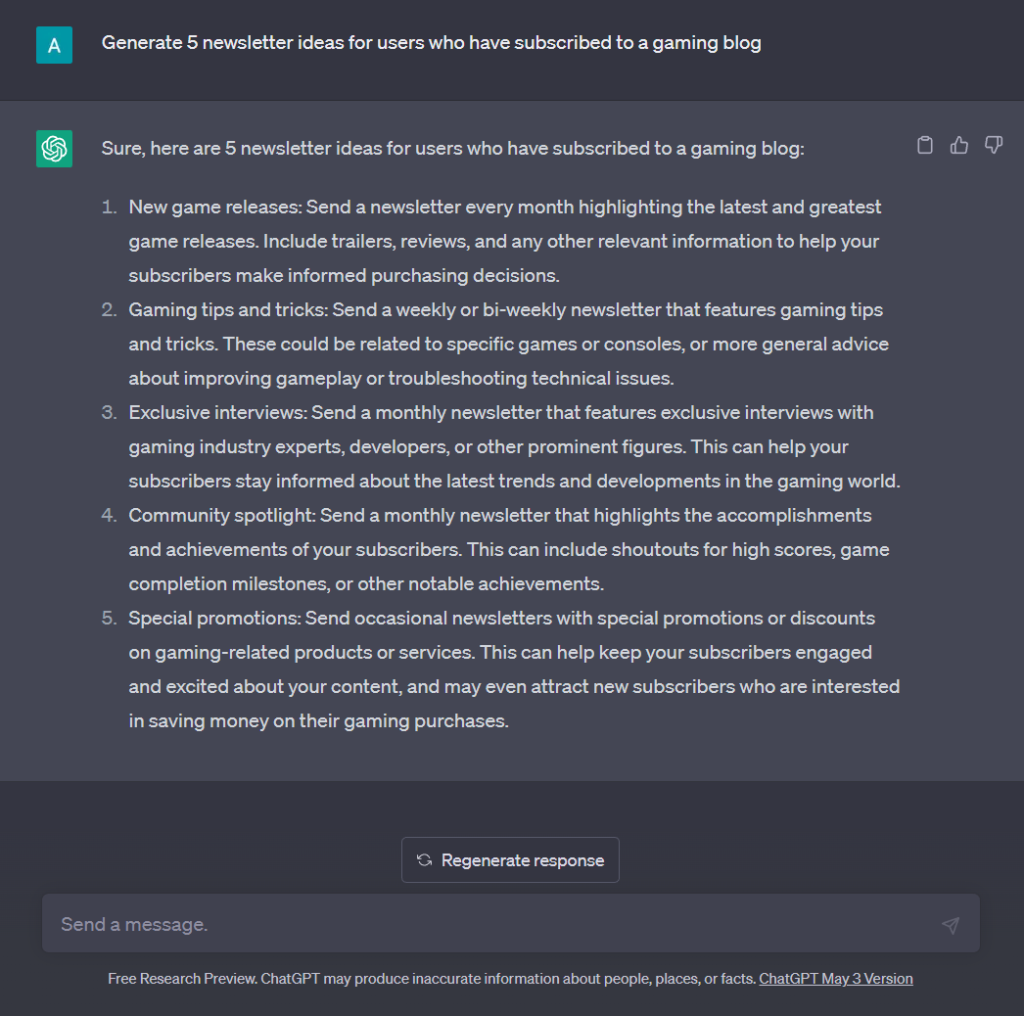
Now, you have some great ideas to send to your subscribers and engage them.
But why stop there?
Let’s write some newsletters using ChatGPT:
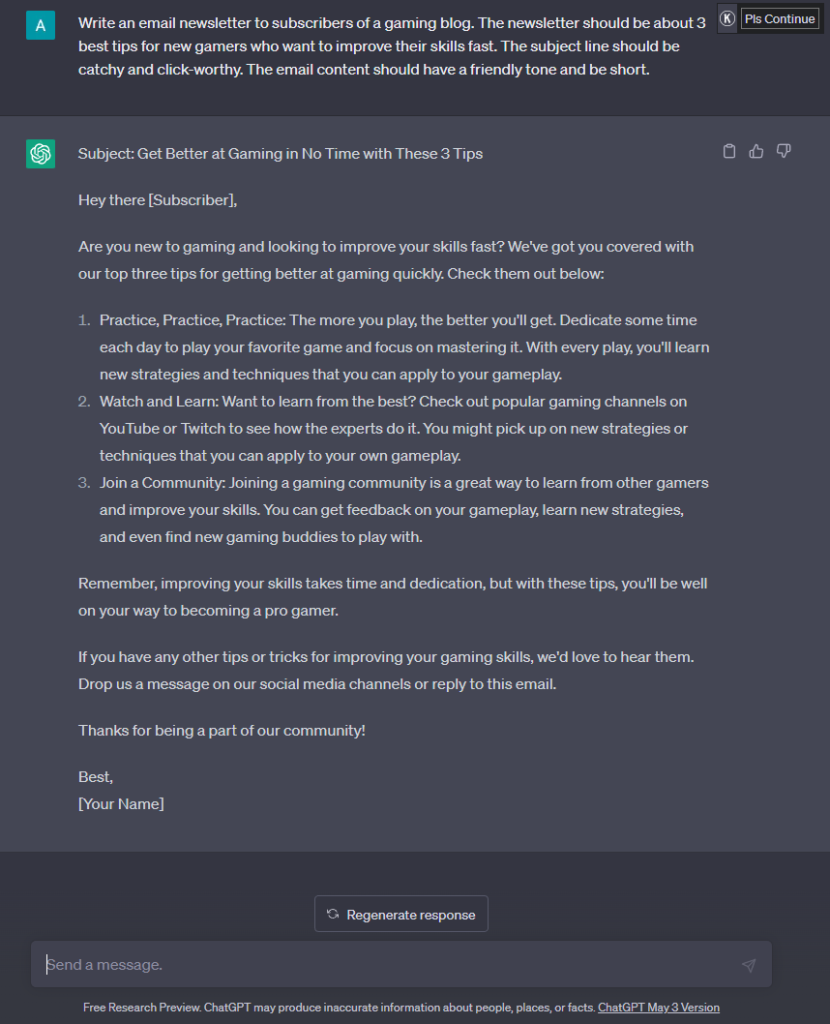
That’s how easy it is to write newsletters for your subscribers using ChatGPT. Now, you shouldn’t just copy and paste the generated output and send it to your subscribers.
Even if you spend 5-10 minutes tweaking and optimizing the output, you can turn the output from ChatGPT into a highly engaging email that your subscribers will love.
Prompt Ideas & Examples
- Generate 5 newsletter ideas for users who have subscribed to a [niche] blog
- Write an email newsletter to subscribers of a [niche] blog. The newsletter should be about [topic].
- Write a promotional email to subscribers of a [niche] blog talking about [topic] and promoting [product name].
Conclusion
From generating blog post ideas to creating content for your blog, ChatGPT has many use cases for bloggers.
By incorporating ChatGPT into your blogging workflow, you’ll not only save time but also be a better and more productive blogger.
Let me know what you think in the comments about ChatGPT and how you use it as a blogger.
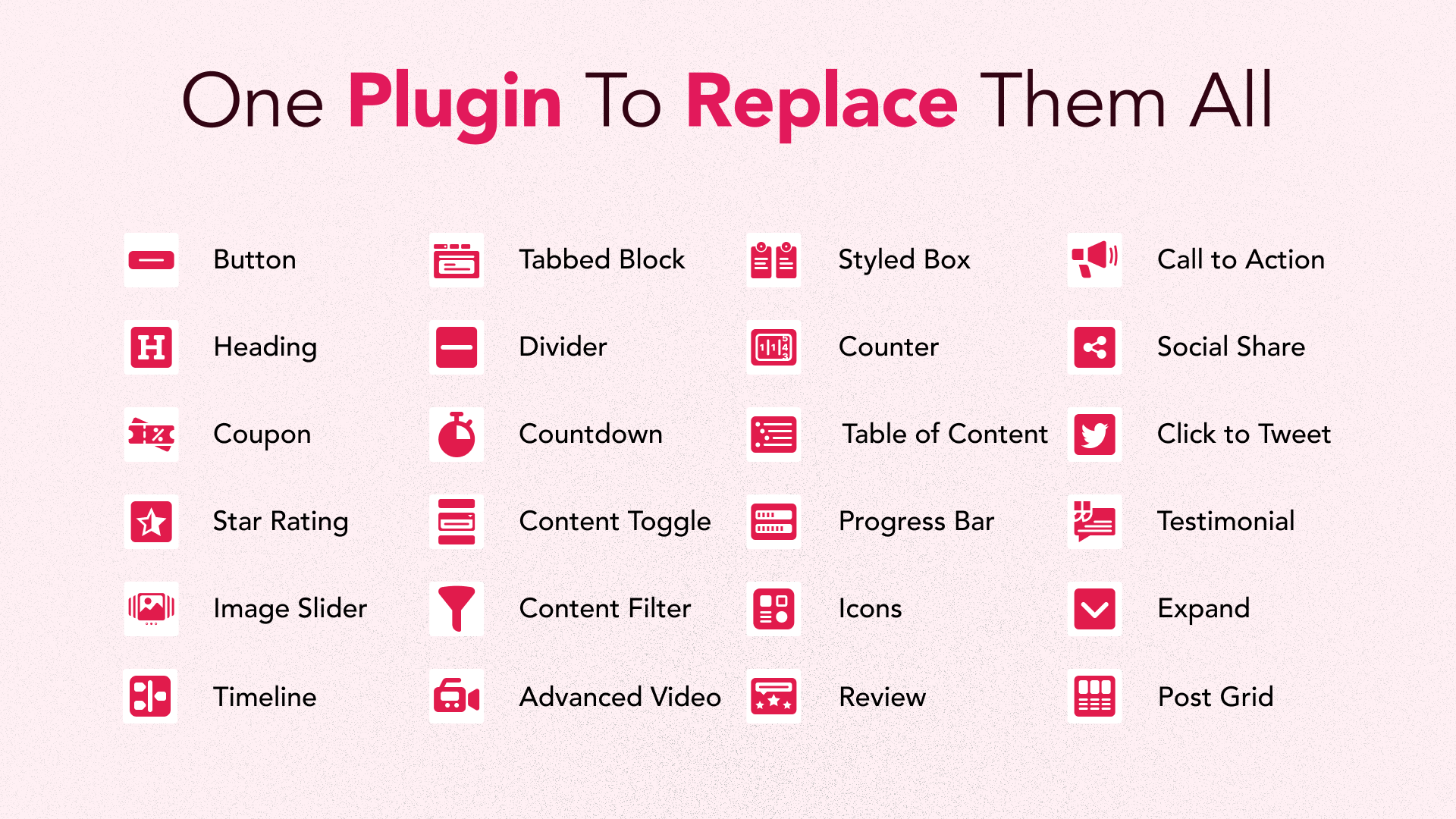
Leave a Reply